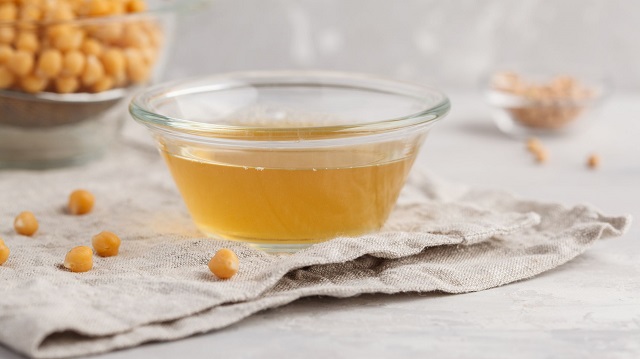Aquafaba is the liquid found within a can of chickpeas. Aquafaba can also refer to the liquid in other types of canned beans, but it is mainly in reference to canned chickpeas.
The word “aquafaba” breaks down into “aqua” for water and “faba” for beans. Essentially, it is bean water. However, when paired with other ingredients, you can’t taste the bean flavor at all. For best results, be sure to use the aquafaba from a can of unsalted chickpeas.
Aquafaba can be used as a binding agent or egg replacement in many egg-free recipes. This opens up a door of possibilities for people with egg allergies, or people who eat a vegan or egg-free diet.
These nutritious aquafaba recipes will inspire you to ditch eggs for this inexpensive bean liquid in meringues, mayonnaise, mousse, and more.
Vegan Pancakes
While pancakes are traditionally made with eggs, vegans and people with egg allergies have been swapping out eggs for creative alternatives for years. The latest craze? Aquafaba.
Pancake batter is usually split into dry ingredients and wet ingredients. The ingredients that make pancakes non-vegan (and off-limits for people with allergies) are usually eggs and milk. Instead of eggs, this recipe calls for four tablespoons of aquafaba. While some aquafaba recipes require you to whisk the aquafaba until it is airy, this recipe does not, making it quick and easy.
Ingredients
For the Basic Dry Pancake Mix:
- 10 ounces all-purpose flour (about 2 cups; 280g)
- 2 teaspoons (8g) baking powder
- 1/2 teaspoon (3g) baking soda
- 1 teaspoon (4g) kosher salt
For Each Batch of Pancakes:
- 4 tablespoons (60ml) liquid from 1 can of low-sodium chickpeas (reserve remaining liquid and chickpeas for another use)
- 4 tablespoons (60g) sugar
- 1 2/3 cups (about 14 ounces; 400ml) almond, rice, or soy milk
- 1/4 cup (60ml) vegetable oil, plus more for cooking
- 2 teaspoons (10ml) vanilla extract
- 2 teaspoons (3g) zest from 1 lemon
- 2 teaspoons (10ml) cider vinegar or distilled white vinegar
- Vegan butter substitute and maple syrup, for serving
Directions
- For the Dry Mix: In a large bowl, combine flour, baking powder, baking soda, and salt and whisk to combine.
- For the Pancakes: Place chickpea liquid and sugar in the bowl of a stand mixer fitted with a whisk attachment. Whisk on high speed until stiff peaks form, about 6 minutes. Meanwhile, combine almond milk, vegetable oil, vanilla extract, lemon zest, and vinegar in a bowl. Add dry mix to wet mix and fold with a rubber spatula to combine (the mixture should remain lumpy). Fold in whipped chickpea liquid, being careful not to let it deflate too much.
- Heat a large heavy-bottomed nonstick skillet over medium heat for 5 minutes (or use an electric griddle). Add a small amount of vegan butter or oil to skillet or griddle and spread with a paper towel until no visible butter or oil remains. Reduce heat to low. Use a 1/4-cup dry measure to place 4 pancakes in skillet and cook until bubbles start to appear on top and the bottoms are golden brown, about 3 minutes. Carefully flip pancakes and cook on second side until golden brown and completely set, about 3 minutes longer. Serve pancakes immediately, or keep warm on a wire rack set on a rimmed baking sheet in a warm oven while you cook the remaining 3 batches. Serve with warm maple syrup and vegan butter.
Click ‘Next Page‘ if you want to see more.
